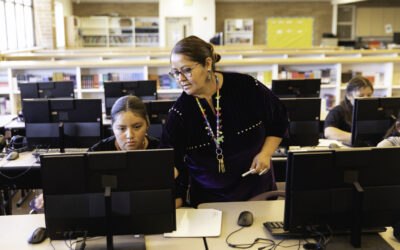Online assessments have become increasingly prevalent in education, especially with the rise of digital learning environments and the need for flexible, scalable evaluation methods. Schools and universities are adopting online assessments for a wide range of purposes, from standardized testing and formative assessments to quizzes and interactive assignments. The frequency of their use has surged, driven by the convenience of administering tests remotely, the ability to provide immediate feedback and the capacity to analyze data on student performance more efficiently. This trend has been further accelerated by global events such as the COVID-19 pandemic, which necessitated a rapid shift to online learning and assessment platforms.
Students’ performance in online assessments often forms a significant part of their overall academic evaluation. These assessments can determine grades, influence academic progression and even impact future opportunities, such as college admissions or job placements. Beyond academic metrics, performance in online assessments also reflects students’ digital literacy and their ability to apply knowledge in a digital context. Given the growing reliance on digital platforms in both education and the workplace, strong performance in online assessments can indicate a student’s readiness for the digital demands of the modern world, making it an essential aspect of contemporary education.
Challenges Facing Students Taking Online Assessments
For students lacking digital literacy skills, online assessments can pose a challenge. These students may struggle with basic digital tasks such as navigating the assessment platform, understanding the use of digital tools and managing technical issues like logging in or submitting their work. As a result, their performance may not accurately reflect their knowledge or abilities, but rather their difficulty in interacting with the digital medium. For example, students unfamiliar with keyboarding may take longer to type responses, causing them to run out of time, while those who are unsure of how to use digital tools like drop-down menus or drag-and-drop features may misinterpret questions or fail to complete tasks correctly. This disparity in digital skills can lead to increased anxiety, frustration and a sense of inequity, particularly when these assessments significantly impact academic outcomes.
The lack of digital literacy skills can also exacerbate existing educational inequalities, disproportionately affecting students from lower socio-economic backgrounds who may have limited access to technology and digital learning resources. These students are less likely to have had opportunities to develop digital proficiency at home, putting them at a disadvantage compared to their peers who are more comfortable with technology. As a result, online assessments can unintentionally widen the achievement gap, as students with inadequate digital skills struggle not because of a lack of content knowledge but due to their inability to effectively use the digital tools required for the assessment. This highlights the need for comprehensive digital literacy education to ensure that all students can participate equitably in online assessments and that their performance is a true reflection of their academic capabilities.
The Role of Digital Literacy in Online Assessments
Digital literacy encompasses a broad spectrum of skills, including the ability to navigate digital platforms, critically assess online information, utilize digital tools for communication and collaboration and understand the ethical implications of digital activities. In the context of online assessments, these skills are crucial. Here are some reasons why:
1. Navigation and Technical Proficiency
To perform well in online assessments, students must be comfortable navigating digital platforms. This includes understanding the user interface, knowing how to move between different sections of an assessment and effectively using tools such as drag-and-drop, highlighting and text entry boxes. Students lacking these skills may struggle, not because they don’t know the content, but because they cannot effectively interact with the digital format.
2. Information Literacy
Online assessments often include tasks that require students to find, evaluate and use information from digital sources. Digital literacy helps students discern credible sources, synthesize information from various platforms and apply this knowledge in an assessment context. Students with strong information literacy are better equipped to handle questions that require critical thinking and the application of knowledge, rather than simple recall.
3. Critical Thinking and Problem-Solving
Digital literacy fosters critical thinking and problem-solving skills, which are essential in online assessments that often present students with complex scenarios or simulations. These tasks require students to analyze information, identify key issues and develop solutions using digital tools. The ability to think critically about digital content and use technology to solve problems directly impacts performance in such assessments.
4. Collaboration and Communication
Many online assessments now include collaborative elements, where students must work together in a virtual environment to complete a task. Digital literacy enables students to communicate effectively using digital tools, collaborate on shared documents and participate in online discussions. This collaboration is often assessed not only for content knowledge but also for digital communication skills, making digital literacy a crucial component of success.
5. Ethical Use of Technology
Understanding the ethical implications of digital behavior is another aspect of digital literacy that affects online assessment performance. Students need to be aware of plagiarism, data privacy and the responsible use of digital resources. Those with a strong foundation in digital ethics are less likely to engage in academic dishonesty, which can negatively impact their assessment results.
6. Assessment Accuracy
Digital literacy skills, including keyboarding, are crucial for students to complete online assessments more effectively, allowing them to navigate digital platforms with ease and focus on demonstrating their actual knowledge. These skills enable students to interact efficiently with assessment tools, manage their time better and reduce errors related to unfamiliarity with digital interfaces. As a result, students can more accurately showcase their understanding of the subject matter, rather than being hindered or slowed by technical challenges, ensuring that their performance truly reflects their academic abilities.
Strategies for Enhancing Digital Literacy
To address these challenges and improve student performance in online assessments as well as for future-readiness, educators must prioritize the development of digital literacy skills. Here are some strategies to consider:
- Implementing a Digital Literacy Program: Implementing a digital literacy program in K-12 classes is essential for equipping students with the skills they need not only to excel in online assessments but also to be future-ready in an increasingly digital world. This program should teach students critical digital skills, including keyboarding, information literacy and safe online practices, ensuring they can effectively navigate digital environments and utilize technology in both academic and real-world scenarios. By fostering these competencies early on, a digital literacy program prepares students for future educational and career opportunities, enabling them to thrive in a society where digital proficiency is increasingly important.
- Integrating Digital Literacy into Curriculum: Digital literacy should be embedded across all subjects, not treated as a standalone skill. For example, teachers can incorporate digital tools into research projects, collaborative assignments and presentations, helping students develop digital literacy in context.
- Providing Access to Technology: Schools and educational institutions must ensure that all students have access to the necessary technology, including devices, reliable internet and digital learning platforms. This access is fundamental to developing digital literacy and ensuring equity in online assessment performance.
- Understanding the Myth of the “Digital Native”: Educators need to be informed about the myth of the digital native, which suggests that all young people are inherently proficient with technology simply because they have grown up in a digital age. This misconception can lead to the false assumption that students naturally know how to navigate online assessments without explicit instruction or practice. In reality, while many students may be adept at using social media or gaming platforms, they often lack the necessary digital literacy skills required for academic purposes, such as navigating complex test interfaces, using digital tools for problem-solving, or typing efficiently. Educators must recognize that these skills need to be taught and reinforced, just like any other academic subject, to ensure that all students can effectively demonstrate their knowledge in an online assessment environment.
- Offering Professional Development for Educators: Teachers need to be equipped with the knowledge and skills to teach digital literacy effectively. Professional development programs should focus on the latest digital tools, instructional strategies for teaching digital literacy and methods for assessing these skills in students.
- Using Formative Assessments to Build Skills: Formative assessments that include digital literacy components can help students develop the necessary skills before they face high-stakes online assessments. These low-pressure assessments provide opportunities for students to practice and receive feedback on their digital literacy.
Online Assessments & Digital Literacy Infographic
This infographic delves into the landscape of online assessments and considers how lagging digital literacy skills impact student performance. It also explores questions like:
- Do pencils make students smarter?
- What does digital literacy look like in action?
- How do these skills enhance student performance?
While the data below is from a pre-COVID world, we still believe it resonates today – perhaps even more so.

Final Thoughts
Digital literacy is not just a supplementary skill but a fundamental aspect of modern education, particularly as online assessments become more prevalent. By enhancing digital literacy, educators can help students perform better in these assessments, ensuring that they are not only evaluated on their content knowledge but also on their ability to navigate and utilize digital environments effectively.
As the landscape of education continues to evolve, the importance of digital literacy will only grow. It is important that educators, institutions and policymakers prioritize the development of these skills to ensure that all students are prepared for success in online assessments and beyond.
Explore Learning.com’s EasyTech digital literacy program to equip your students with the essential digital skills they need to excel in online assessments and prepare for future success. Empower your students today with the tools and confidence to thrive in a technology-driven world.
This article was originally published in March, 2021 and was updated for additional information for completeness and relevance in October, 2024.

Learning.com Team
Staff Writers
Founded in 1999, Learning.com provides educators with solutions to prepare their students with critical digital skills. Our web-based curriculum for grades K-12 engages students as they learn keyboarding, online safety, applied productivity tools, computational thinking, coding and more.
Further Reading
CIPA Compliance Made Easy with Learning.com
The Children’s Internet Protection Act (CIPA), enacted by Congress in 2000, addresses concerns about children’s access to harmful online content. It...
Students as Logical Thinkers: How Computer Science Teaches Real-World Skills
There is little debate that computer science education has become an imperative curriculum for future-ready students. From modern professions and...
The Digital Readiness Divide in Education
Following access and connectivity, the second digital divide refers to digital readiness, or the skillset that enables people to use technology as...




